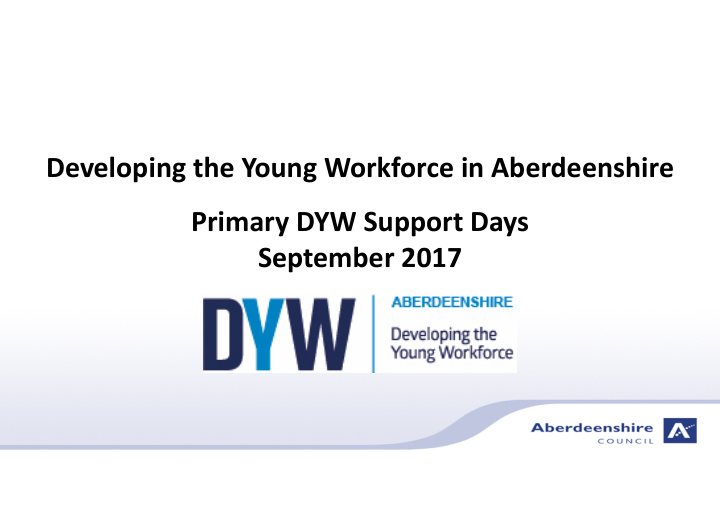



Developing the Young Workforce in Aberdeenshire Primary DYW Support Days September 2017
Government Policy Framework Priorities https://www.youtube.com/watch?v=ItE6dyAA8eA
Where are we with DYW? • Excellent practice in our schools - consistent & sustainable? • Priorities for schools – Career Education Standard – Skills Development (SfLLW) – Partnership Development (including employer, parent & pupil engagement) • Our Planning – Aberdeenshire NIF Plan – Aberdeenshire Excellence and Equity Plan – Aberdeenshire DYW Strategic and Operational Plans – School Improvement Plans • DYW Aberdeenshire Website www.dywaberdeenshire.org
How Good is our School 4? 3.3 CREATIVITY AND EMPLOYABILITY Theme 4: Increasing employability skills Features of highly effective practice: � The school audits practice using the entitlements and expectations in the Career Education Standard . � Young people experience rich work-based learning . This enables them to make informed career choices. � There are clear expectations for young people, employers, schools, local authority, parents and carers before, during and after work placements . Challenge questions: � How well are we working with learners, parents and carers, employers, colleges and other partners to develop an effective approach to careers education ? � How knowledgeable and up-to-date is our school team about career and employability prospects?
HGIOS 4 Core Quality Indicators: • 1.3 Leadership of Change • 2.3 Learning, Teaching and Assessment • 3.2 Raising Attainment and Achievement • 3.1 Ensuring Wellbeing, Equality and Inclusion Permeating themes : � Learning pathways, particular senior phase provision � Development and promotion of partnerships � Recognition of wider achievement � Supporting transition and progression towards positive sustained destinations
Career Education Standard 3-18 Implementation Review • Majority of practitioners aware of the CES 3-18 but .... varies according to their level of involvement with DYW • Whilst practitioners are increasingly engaged in the delivery of DYW this is not always fully aligned with the CES. • Where local authorities have adopted a pro-active approach in coordinating the implementation there is a higher degree of awareness and realisation of the standards and guidance in schools. • The overall pace of implementation has to increase. “ Most practitioners indicated that they incorporated learning about the world of work in their learning and teaching. This was not always obvious to learners .”
Inspection analysis Where schools are successful in relation to the implementation of DYW the following features are evident: • Effective partnership working (parents, local business, colleges, Skills Development Scotland (SDS), Chamber of Commerce, the local community) • Strong leadership • DYW firmly rooted in school’s vision , values and aims
Inspection analysis – improvements: • Implement the Career Education Standards (3 – 18) and the Work Placement Standards (particularly in early years and primary); • Use DYW as a key driver when reviewing school vision, values and aims; • Ensure skills for learning, life and work encompass and are central to the whole curriculum; • Increase the range of progressive learning pathways; • Extend the use of partnership working; • Ensure children can articulate the skills they are developing and their relevance to learning, life and work; • Develop effective tracking systems.
Looking Forward – reflective questions Reflection: Considering the scope that DYW/ the Career Education Standard provides. • What opportunities and challenges can you identify for your work within your school? • What actions do you intend to take forward this session?
Planning ahead – some thoughts • Work strategically – leadership matters • Make the Career Education Standard 3-18 central to your planning • Make DYW an approach, not a project • Put children and young peoples’ aspirations at the centre (entitlements!) • Build on existing structures and experiences • Develop your partnerships • ‘Double dividend’ wherever possible • Consider data and your context and…
What next from Education Scotland? • In the light of the CES 3-18 Implementation review we collaborate with local authorities to develop tailored support . • Working group to consider guidance on profiling in relation to DYW. • Further develop STEM National Strategy to publication by autumn. • RAiSE project now gaining momentum • Gender balance (resources on NIH) and equalities remain key priorities. • Collate and disseminate exemplification to support CES implementation • Primary school focus to increase coherence and progression • Capacity building: � Professional Learning Reference Group to consider professional standards and leadership qualifications � Collaboration with SCEL on ‘Excellence into Headship’ framework
DYW Aberdeenshire Strategic Development Areas for 2017-18 3 Key Focus Areas for 2017-18 • Career Education • Skills for Learning, Life and Work • Partnership Development (including employer, FE, HE, parent & pupil engagement) Equalities Plan • Plan for LAC and most vulnerable • Plan for gender and minorities Staff Development through DYW CLPL & In-service Plan DYW Parental Engagement DYW Website and Social Media Development Work Placement Policy Aberdeenshire Council as an employer 3-18 School Support • Awareness raising/sharing good practice/pathways and partnership DYW Strategy Development
Recommend
More recommend